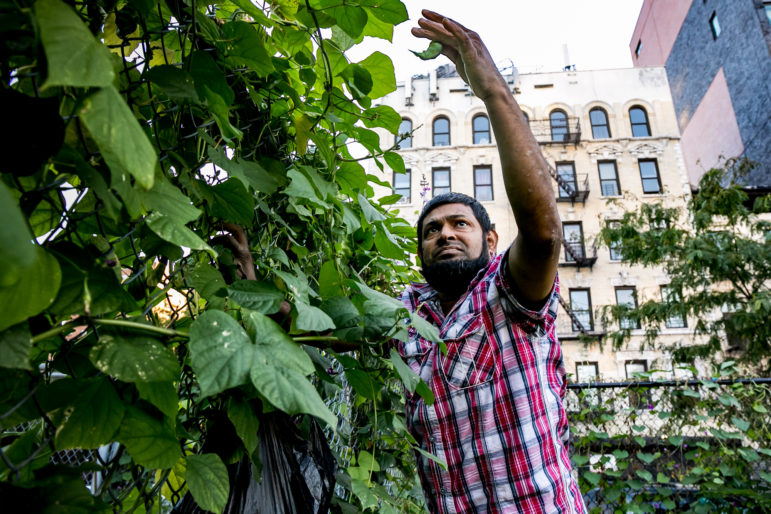
Adi Talwar
Mohammed-Uddin has been planting and harvesting beans by the East Harlem Little League field fence near 111th Street for years. Parcels adjacent to the field could see housing development.
When City Council Speaker Melissa Mark-Viverito and her team of East Harlem community organizations released their neighborhood plan last February, stakeholders wondered whether the city would heed their demands.
The East Harlem Neighborhood Plan, crafted in response to the de Blasio administration’s announcement that it would seek to rezone East Harlem, includes over 200 recommendations on issues across the spectrum, from housing construction and senior services, to NYCHA and small businesses. The planning process harnessed the expertise of 21 steering committee member organizations and dozens of other groups.
Though the Department of City Planning (DCP) has yet to release a rezoning proposal in response to the plan—a DCP presentation is scheduled for the Community Board 11 meeting this October—multiple city agencies have been meeting with the East Harlem groups to discuss steps for implementing the plan’s ideas. In addition, a number of housing development projects on public land are underway in the neighborhood, testing the plan’s shaping power. City agencies frequently invoke the plan in their project summaries, and some stakeholders are impressed by the amount of attention the administration is paying to each project. Others, however, feel the administration has still not offered sufficient commitments to housing for families with the lowest incomes and good construction jobs.
East Harlem is considered one of the city’s most rapidly heating markets, with 12,000 residents already rent-burdened and on average 360 units coming out of rent stabilization programs annually, according to the plan. The plan recommended that in the event of a rezoning, the city ensure that 50 percent of total new housing would be income-restricted units, and that 20 percent of those affordable units be for families making 30 percent of area median income (AMI) or below, or $24,480 for a family of three. The city could ensure those levels of affordability through the use of the city’s mandatory inclusionary housing policy on private land and by ensuring new housing built on public land was 100 percent rent-regulated, the plan said.
In addition, the plan recommended that the city achieve permanent affordability by working with nonprofits and community land trusts that make affordability their mission. It also called for steps to ensure contractors pay living wages, hire local workers and work with state-approved apprenticeship programs.
Not every stakeholder in East Harlem liked the speaker’s plan. Some felt excluded from the process and saw it as an attempt to repress community concerns about the looming rezoning. But it does represent the most detailed community plan to emerge during the two-plus years of the de Blasio administration’s focus on local rezonings.
The plan’s housing affordability goals weren’t outlandish: The administration had already said that in East New York, its first rezoned neighborhood, 50 percent of the new housing would be rent-regulated, and it committed to building 100 percent regulated housing on several parcels of public land there. East Harlem has an abundance of public land: 44 percent of the neighborhood’s land is owned by NYCHA or city agencies. The plan listed six large public sites where substantial amounts of affordable housing could be constructed, along with seven “pipeline sites”—on both public and private land—that the city is already working toward developing.
Yet several questions remain. Right now, the city’s affordable housing subsidy programs provide for no more than 15 percent of units at the lowest affordability levels, not the 20 percent called for in the East Harlem Plan. It’s not clear yet whether the de Blasio administration will embrace East Harlem planners’ desire to see a larger role for community land trusts and other non-profit developers. And though de Blasio beefed up the city’s local hiring stipulations for publicly subsidized projects last year, advocates say the city still needs a plan to ensure developers pay prevailing wages and use apprenticeship programs.
How low to go on a big public site?
While the de Blasio administration has yet to release a neighborhood-wide plan for East Harlem, several proposals already under consideration could reshape parcels that will be important to the overall direction of the community.
The neighborhood’s largest public site—nearly the entire block between East 111th Street, East 112th Street, Park Avenue and Madison Avenue—currently contains six community gardens and a baseball field. The East Harlem Neighborhood Plan notes it as a potential site for affordable housing.
The Department of Housing, Preservation and Development (HPD) began hosting community visioning workshops for the site just after the release of the East Harlem Neighborhood Plan and this summer released a Request for Proposals (RFP) for the creation of a 400-unit energy-efficient development that is 100 percent rent-regulated, with space for retail, community facilities as well as four of the six existing gardens.
The RFP does not specify the income levels for the site, noting only that the development must provide for a mix of incomes up to 165 percent AMI ($134,640 for a family of three), and maintain those affordability levels for at least 30 years. HPD says it will give preference to developers who plan to include more units for families making the lowest incomes, who promise to keep the site affordable for longer and who commit to local hiring. The RFP also includes a copy of the East Harlem Neighborhood Plan in its appendix. The chosen developer is expected to work with HPD to apply for an upzoning of the site.
While the city says it is committed to deep affordability on the site, the RFP wasn’t good enough for members of Community Voices Heard, a lead facilitator of the plan. On August 17, they rallied with members of Picture the Homeless and New York Communities for Change to demand the RFP require a specific percentage of units for families making the lowest incomes.
Independent from other steering committee members and from the speaker’s office, Community Voices Heard is demanding more than the plan: that all projects on public sites include not only 20 percent, but 40 percent of units for families making less than 30 percent AMI.
Chris Cirillo, the director of the affordable housing developer Lott Community Development Corporation and the facilitator of the plan’s housing subgroup, says he is pleased with many aspects of the RFP, including its design standards, inclusion of community garden space, and attention to the revitalization of Park Avenue. He also notes that with a limited amount of city subsidy available, neighborhoods must grapple with the tradeoff between creating more rent-regulated units and reaching deeper affordability levels.
“Certainly the best chance to get that level of low, low, deepest affordability is on public sites,” he says.
Differing visions on a garbage garage
Many of the other public sites listed in the plan would be more challenging to develop because they contain significant existing uses, such as a high school or NYPD vehicles. For instance, neighborhood stakeholders have long sought to relocate the sanitation garage at East 99th Street, which is in the middle of a residential area and adjacent to a hospital, but continue to disagree with the city about where to relocate it.
The Department of Sanitation has proposed leasing a private site on East 127th Street, currently home to an auto mall, to house its vehicles. Community Board 11 opposes this choice because the site is located near a school and a cancer treatment center. Many trucks would be parked outdoors, and the site is blocks away from another sanitation garage serving Central Harlem, raising concerns about air quality. Some board members are also concerned that the owner of the site was once the recipient of Industrial Development Agency bonds, meant to stimulate economic development and job growth in the area, but could now benefit from leasing its property to the city for municipal purposes.
“We request that the Department of Sanitation consider alternative sites within our district, including Randall’s Island, for a new enclosed facility for the….garage and that a list of these sites be provided to our office with an explanation as to the feasibility of each site considered,” wrote chair Diane Collier to the sanitation department in May.
In August, however, the department of sanitation released an Environmental Assessment Statement declaring the project would have no negative environmental impacts.
“In response to community concerns, DSNY and the landlord have added an opaque fence and rollup doors to the site plans to screen the site from passersby. … The relocation of the M11 Garage to the E.127th Street site will not result in any increased traffic or equipment servicing M11,” wrote Vito Turso, a spokesperson for Sanitation, in an e-mail to City Limits. In the past, the department has said they don’t have the land or money to build a new facility, according to community board member Marie Winfield.
Key sites targeted
The seven pipeline sites listed in the plan include projects in different stages of planning, some proposed long before the plan’s release. For instance, there’s the ongoing redevelopment of East 125th Street, the outcome of a community engagement process that began in 2003. That project will offer affordable housing at a variety of income levels but only 5 percent of units for families making less than 40 percent AMI, according to an analysis of a December press release.
For two pipeline sites that were the subject of hearings this year, neighborhood stakeholders are trying to make sure the plan has influence.
EDC is currently working with neighborhood stakeholders to develop a memorial and mixed-use project for one of the sites, at a location where a former cemetery where archeologists have discovered the desecrated remains of freed and enslaved Africans. EDC’s draft scope of work for the project notes that their proposal is “informed by and are consistent with the cultural heritage protection, economic development, and affordable housing goals identified in the East Harlem Neighborhood Plan.”
Though the contours and affordability levels of that development have yet to be determined, one possible scenario explored in EDC’s draft scope of work includes 50 percent market-rate units. That scenario alarmed many members of the public at a hearing last week.
“There’s a lot of public land that seems to be popping out of nowhere, and it’s not being targeted for the community itself,” testified Ray Tirado, a member of Community Voices Heard.
Mark-Viverito’s representative called for deep affordability and a maximum number of affordable units, while a representative for Borough President Gale Brewer recommended that 100 percent of units be affordable to families making between 30 and 130 percent AMI.
Participants in the task forces that are helping to plan the development told City Limits that different models and affordability levels are truly still under discussion.
“EDC has been pretty good about working with the community partners on this and the task force members, and I think the task force members are sufficiently vocal,” says Jamison Mitchell of Civitas, a member of both a task force for the project and the neighborhood plan’s steering committee. “I don’t think the wool is going to be pulled over anybody’s eyes.”
Another pipeline site, Lexington Gardens II at East 107th street, is currently undergoing public review through the Uniform Land Use Review Procedure (ULURP). Part of the site is public land, and the other part is owned by Tahl-Propp Equities. HPD, Tahl-Propp and L&M have proposed the construction of 390 units of affordable housing, along with retail space and two youth-focused centers. 20 percent of units will be affordable to families making up to 130 percent AMI and 50 percent of units will be for families making up to 47 percent AMI. Those rent restrictions would be in place for at least the next 30 years. Another 30 percent of units for families making up to 80 percent AMI would be permanently affordable through the city’s mandatory inclusionary housing policy.
Both Tahl-Prapp and L&M have a history of working with the de Blasio administration to preserve affordable housing by extending affordability agreements, and Tahl Propp has recently met the demands of Community Board 11 and Mark-Viverito to enter into a new regulatory agreement for its neighboring Lexington Gardens property, ensuring the building’s continued affordability for the next 35 years.
On July 19, the community board approved the project by a 20 to 13 vote, with five abstentions. Those who approved it praised the developers’ affordability commitments, its preservation efforts, and its jobs plan. Those who opposed said that the project did not have units for families making less than 30 percent AMI, that the developers could only guarantee permanent affordability for 30 percent of the units, and that the development team had not made a presentation to the full board.
“We’ve never had a project big or small go through ULURP and…not give a presentation,” board member Alvin Johnson told City Limits.
Borough President Brewer, citing other buildings where Tahl-Propp has failed to maintain building conditions, recommended the approval of the project on the condition that the development team create a mechanism to ensure proper oversight of management, and that the city create a restrictive covenant on the deed to ensure permanent affordability.
The role of East Harlem’s community board
Johnson’s complaint about the lack of a presentation at the full board meeting may seem trivial to some; the development team had already presented a few times to the land-use committee. Yet it goes to the heart of one of East Harlem’s greatest challenges today: ensuring the public understands the technical details of each of the proposals currently under review.
Community boards play an important role in informing the public about land use changes, holding public hearings, voting on projects and making recommendations to other government offices, but as all-volunteer bodies they face their own challenges of limited time and financial resources.
The city’s procedures for land-use changes and environmental review are infamously challenging to understand, filled with technical language that can easily overwhelm. At the hearing for the African Burial Ground scope, there were complaints from a few audience members that city officials were not speaking in comprehensible English.
In September, Board 11 members Winfield and Johnson released a petition expressing concern about “the transparency and accessibility of the processes that determine the future of our communities” and critiquing the board’s performance, such as the lack of Spanish interpreters at an important hearing, and the failure to lodge an official comment—so far—on the African Burial Ground proposal.
Others told City Limits they regretted that Winfield and Johnson, among several other members of the land-use committee, were reassigned by chair Collier to other committees for the 2016-2017 year. The reassignment took place before the release of the petition but after Winfield and Johnson had both voted against Lexington Gardens II and made their qualms known. Collier did not respond to requests for comment.
Some questioned why board member Vincent Torres, whose organization Positive Workforce is a partner in the Lexington II project, had not excused himself from the vote. Torres did not respond to requests for comment.
To prepare the board for its increasingly significant role, the petition recommends that the board commit to translating relevant materials into Spanish, increase the accessibility of ULURP materials and board agendas for the public, hold separate hearings for the upcoming East Harlem neighborhood-wide rezoning ULURP and draft scope, create more ways for the public to submit comments, and hire a parliamentarian to ensure the community board complies with rules.
For Winfield, these measures are vital to ensure the board is not overwhelmed by the deluge of forthcoming projects.
“I think the issue is having so many ULURP applications that are coming piecemeal,” she says. “The community really misses out on a chance to have a comprehensive look at the number of units that are going to impact a small geographical area and then to really have complete and comprehensive environmental assessment of the impact.”
Joe Marvilli, a spokesperson for DCP, said that each project’s analysis will take into account the potential impacts of other planned projects in the area, and that implementation of a neighborhood-wide rezoning will itself require review and acknowledge the individually proposed projects in the area.
“We strongly support the efforts of Speaker Mark-Viverito and local stakeholders to realize a comprehensive neighborhood plan, but we also believe it is vital to continue delivering affordable housing with the tools we have in hand,” Marvilli said. “Ultimately, we believe the plan for these sites, which will be subject to full public review, will be consistent with the priorities laid out by the Speaker and community.”
UPDATE: DCP will no longer present its draft rezoning framework for East Harlem at the Community Board 11 land-use committee meeting on Wednesday October 12, but will still present at the full board meeting on Tuesday October 18, 6:30 pm at the Children’s Aid Society on 130 E 101st Street.


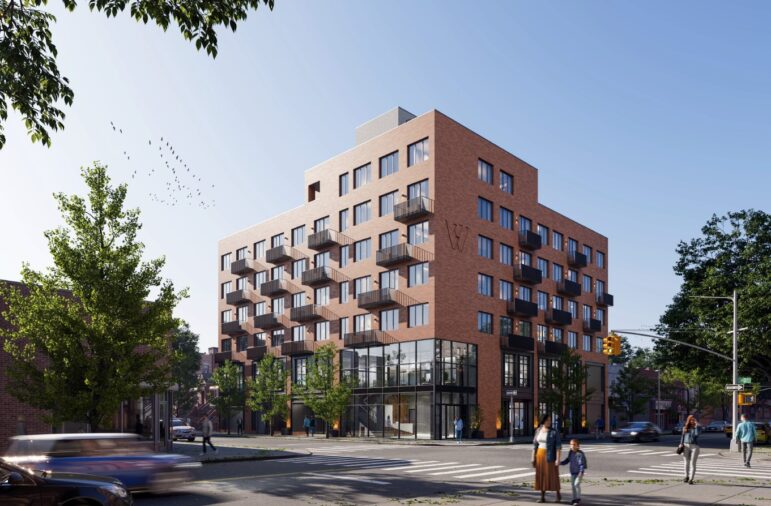
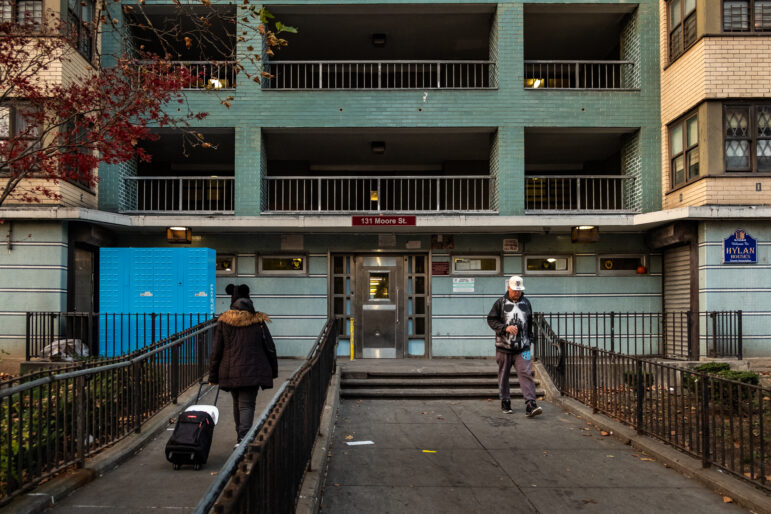
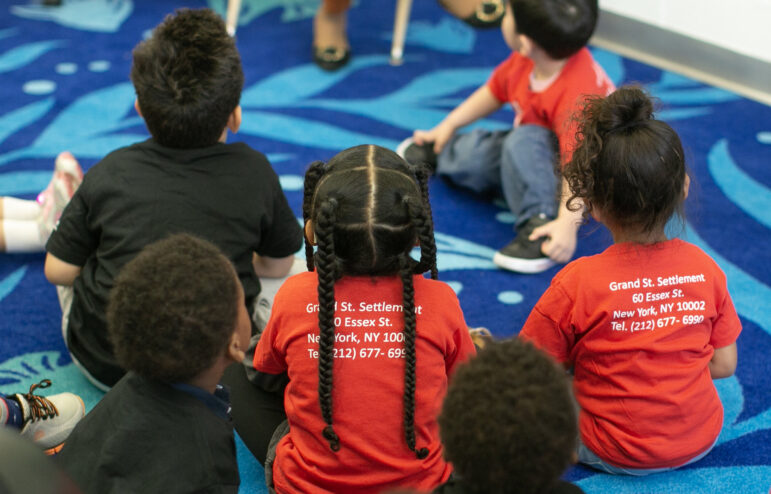

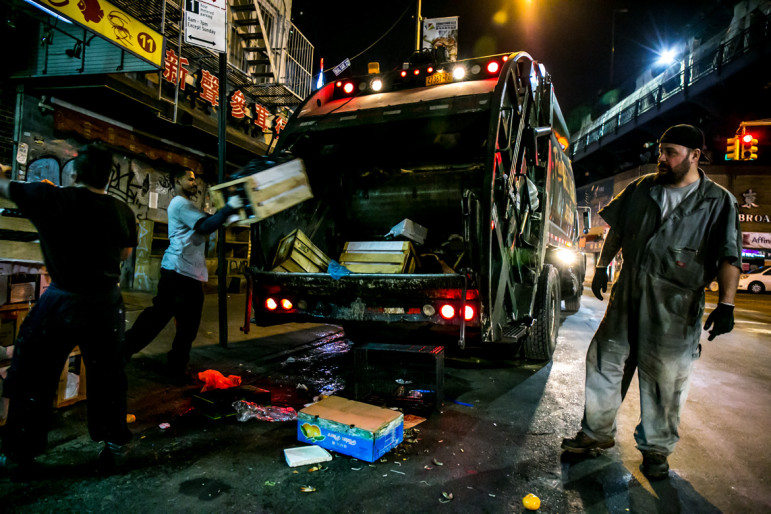


2 thoughts on “Fate of Council Speaker’s East Harlem Plan Uncertain”
Pingback: News - October 2016 - East Harlem Preservation
Winfield and Johnson appear to be two key CB members who both understand these complex procedures and are fighting for communities aware input and informed consent. And pretty clearly with no ‘skin in the game’. No community should be expected to just ‘trust us’ by this (any?) administration. The complete incompetence (at best) that gave us Rivington House debacle is just one example. The influence of high-end real estate developers, PR firms and lobbyists who have had easy access to City Hall while community boards and Council Member warnings (that went through the “proper (only) channels”) went unheeded means the administration has some hard work to do to get any credibility back. There is no pass just because one claims the mantle of “progressive”.
And having a board member NOT recuse themselves on a project when they have a blatant vested interest?
Wondering why on public land affordable units aren’t required to be permanently affordable (30 years is a minute in NYC). What is the profit margin the developers hope to achieve? What do their CEO’s make? I assume not-for-profit affordable housing developers would have a lower profit margin than a profit-making developer? Anyone know?